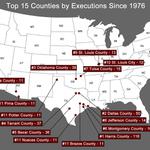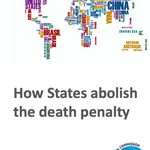Publications & Testimony
Items: 3211 — 3220
May 13, 2013
NEW VOICES: Nebraska Senator Changes Course After Hearing from Victims’ Families
As Nebraska’s legislature began debate on a bill to repeal the death penalty, one senator explained how his views on the issue had evolved. In an op-ed in the Lincoln Journal Star, Sen. Colby Coash said that his participation with a group celebrating an execution led him to oppose the death penalty: “I made a decision during my shame that I would no longer be a part of someone’s death.” A second influence was his conversations with relatives of murder victims. He…
Read MoreMay 10, 2013
BOOKS: “Women Who Kill Men” – An Historical and Social Analysis
Women Who Kill Men: California Courts, Gender, and the Press examines the role that gender played in the trials of women accused of murder in California between 1870 – 1958. The authors trace the changing views of the public towards women and how these views may have affected the outcomes of the cases. Some defendants faced the death penalty and were executed; some were spared. Often the public was deeply fascinated with all aspects of the trial and…
Read MoreMay 09, 2013
EDITORIALS: Colorado Case Raises Doubts About Entire Death Penalty System
Colorado recently set an execution date in August for Nathan Dunlap, who has been convicted of multiple murders. This would be first execution in the state in 16 years. In an editorial, the Aurora Sentinel recommended that the governor spare his life, not because of doubts about his guilt, but because of doubts about other aspects of the process that led to his death sentence: “There is simply too much doubt about the effectiveness of the death penalty. There is too…
Read MoreMay 08, 2013
DEATH ROW: Reporter Describes Conditions on California’s Death Row
Nancy Mullane, a reporter for KALW Radio in San Francisco, is one of the few reporters to visit California’s death row at San Quentin Prison. In the block she visited, there were 500 inmates, in 4‑by-10 foot cells, stacked five tiers high. The cells are about the size of a walk-in closet. Many of the inmates have been on death row for over 20 years. Inmates can shower every other day. One of the inmates she met with, Justin Helzer, had stabbed himself in both eyes. He later…
Read MoreMay 07, 2013
NEW VOICES: Former Law Enforcement Officials, Judges, Faith Leaders Urge Commutation for Colorado Inmate
On May 6, more than 20 former judges and prosecutors, religious leaders, mental health experts, and many others called on Colorado Governor John Hickenlooper (pictured) to commute Nathan Dunlap’s death sentence to life in prison without the possibility of parole. The group’s statement cited racial and geographic disparities in the state’s application of capital punishment as reasons why Dunlap should not be executed. Among those sending letters supporting…
Read MoreMay 06, 2013
FROM DPIC: ‘The Death Penalty by County’ Underscores Geographic Disparities
The Death Penalty Information Center is pleased to offer a new set of data illustrating the geographic arbitrariness of the death penalty. The new section, The Clustering of the Death Penalty, demonstrates that capital punishment is actually carried out in only a small percentage of U.S. jurisdictions. DPIC analyzed the counties within states that are responsible for the most executions, the most death row inmates, and the most recent death sentences. For example, one map…
Read MoreMay 03, 2013
Execution Approaching While Key DNA Evidence Remains Untested
UPDATE: Execution stayed by Mississippi Supreme Court. Since 1994, Willie Manning, an inmate on Mississippi’s death row, has been requesting DNA testing of critical evidence recovered from the crime scene of the murders that led to his conviction. Manning’s conviction was based mainly on circumstantial evidence. In April the Mississippi Supreme Court narrowly (5 – 4) denied the DNA testing being requested.
Read MoreMay 02, 2013
INTERNATIONAL: New Report Examines Countries That Have Abandoned Death Penalty
In April, the International Commission Against the Death Penalty (ICDP) released a new report titled, How States Abolish the Death Penalty. The report examines the experiences of 13 countries, including Argentina, France, Haiti, the Philippines, South Africa, and 2 states in the U.S. (Connecticut and New Mexico), in their paths to ending capital punishment. The report noted that some states took intermediary steps to abolition, including establishing an official…
Read MoreMay 01, 2013
NEW RESOURCES: “Death Row USA” Winter 2013 Now Available
The latest edition of the NAACP Legal Defense Fund’s Death Row USA showed a continuing decline in the number of people on death rows across the country. As of January 1, 2013, there were 3,125 inmates under a sentence of death, a decrease of 43 from a year ago. Over the last decade, the size of death row has dropped almost 16%, from 3,703 inmates in 2000 to 3,125 in 2013. California continued to have the largest death row population (727), followed…
Read MoreApr 30, 2013
EDITORIALS: Miami Herald Calls on Governor to Block Fast-Track Executions
An editorial in the Miami Herald called on Florida Governor Rick Scott (pictured) to veto a bill recently passed by the legislature requiring the governor to sign a death warrant within 30 days after state Supreme Court review, with the execution taking place within 180 days after that. The editorial listed several death row inmates who were exonerated after spending more than 10 years on death row, and noted, “All of them might have been executed if the legislation…
Read More








